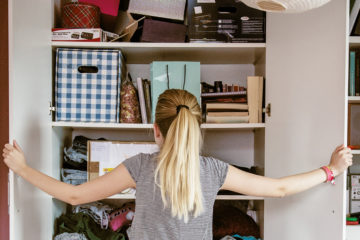A thoughtful approach to garage storage makes the most of this valuable space and keeps every necessity at your fingertips.
If your house is bursting at the seams, or simply short on storage options, the solution may be as close as your garage. To make the best use of this space, however, you first need to corral its current chaos.
This is, fortunately, a relatively simple task if you incorporate a few good storage ideas. With careful planning and a little effort, you can transform your garage from a messy catchall to an efficient, well-organized household annex.
Divide and conquer
First things first: Get rid of anything you no longer use. After you’ve winnowed down the contents of your garage, sort everything into groups. Keep garden tools with garden tools, and sports equipment with sports equipment. Items used together ought to be stored together.
Where possible, place like items into clear plastic containers with lids. It’s fine to use opaque bins, just be sure to label each one. Stackable containers are especially handy. They keep your belongings clean, protect against insects and rodents, increase the amount of usable floor space, and cut down on visual clutter.
What goes where?
The efficient use of space partly depends on positioning stored items in a thoughtful, strategic way. Are there certain items you’re likely to need on a regular basis, such as cleaning supplies? If so, store them near the door so you can access them quickly and easily. Stash rarely used or seasonal items, like sleds and skis, in harder-to-reach spots.
Off the wall
The key to garage storage and organization is getting things off the floor. Capitalizing on wall space enables you to fit the most into your garage, while keeping it all visible and easy to access. The type of wall storage you choose depends on your storage needs, project budget and personal preferences. Many homeowners opt for one or a combination of the following storage standbys:
Pegboard. A favorite for generations, pegboard is inexpensive and easy to install. Because it can be outfitted with an array of compatible hooks, clamps, bins and shelves, pegboard can be used to store and organize just about anything, as long as the item to be stored isn’t especially heavy.
Open shelving. Whether a wall-mounted track system or a set of stand-alone units, open shelves are affordable, versatile and user-friendly, and they keep everything in plain sight. Plus, depending on their construction, 12- or 16-inch-deep shelves are typically capable of holding heavier items.
Closed cabinetry. If you plan to park your car in the garage, cabinets with doors may be the most desirable option, because closed storage means not having to come face-to-face with paint cans and garbage bags every time you leave or arrive home. Cabinets are available in countless materials and styles, but generally speaking, they are more expensive than other solutions. And because they are unable to accommodate very large items, cabinets are most effective when used in conjunction with another storage system.
Panelized systems. Here, entire walls are covered with specially designed panels that hold any number of companion add-ons, such as hooks and shelves. Unlike pegboard, panelized systems can handle heavier items. But that strength and utility comes at a cost, especially since some proprietary products must be installed by licensed professionals.
Look up
For certain infrequently used belongings, the ceiling provides ideal, out-of-the-way storage space. Ladders and seasonal gear can be kept here, hung by clips or straps fastened to the ceiling joists. Or you can take advantage of hoist pulley systems, which cleverly operate like the cords on window blinds. Bear in mind, however, that ceiling storage must be oriented so that it doesn’t interfere with the operation of the garage door.
Safety steps
As you’re organizing your garage, it’s important to keep safety in mind. It’s unsafe to store gasoline and propane in the garage; a single spark could lead to tragedy.
Likewise, if you have children or pets, you should store hazardous materials like fertilizer and pesticides far out of reach. Locked cabinets are a good solution for these toxic materials, and they’re also a smart place to store power tools and sharp implements.
Related:
Originally published January 2015.… Read More








